3805NRS Case Study: Nursing Interventions for Older Adult Patient
VerifiedAdded on 2022/09/28
|10
|2382
|25
Report
AI Summary
This report presents a comprehensive nursing care plan for a 71-year-old female patient post-amputation, addressing critical nursing priorities. The plan emphasizes nerve pain management using patient-controlled analgesia, with careful monitoring for local anesthetic toxicity and vital signs. It highlights the importance of VTE prophylaxis to mitigate the risk of pulmonary embolism, considering the patient's history of lupus and potential complications. Additionally, the plan details pressure area care to prevent bedsores, given the patient's limited mobility. The justification section explains the rationale behind these interventions, emphasizing the need for vigilant monitoring, evidence-based practices, and the impact of comorbidities on the patient's functional status. The discussion section delves into pain management strategies, including the use of deep breathing techniques, and the importance of maintaining personal hygiene and bed positioning. The strategy section outlines expected outcomes, such as improved pain levels and the prevention of infections and pressure injuries. The report is well-supported by recent scholarly sources, providing a thorough analysis of the patient's needs and a detailed guide for effective nursing care.

Running head: NURSING 1
Nursing
Student name:
Student ID:
Author’s note:
Nursing
Student name:
Student ID:
Author’s note:
Paraphrase This Document
Need a fresh take? Get an instant paraphrase of this document with our AI Paraphraser
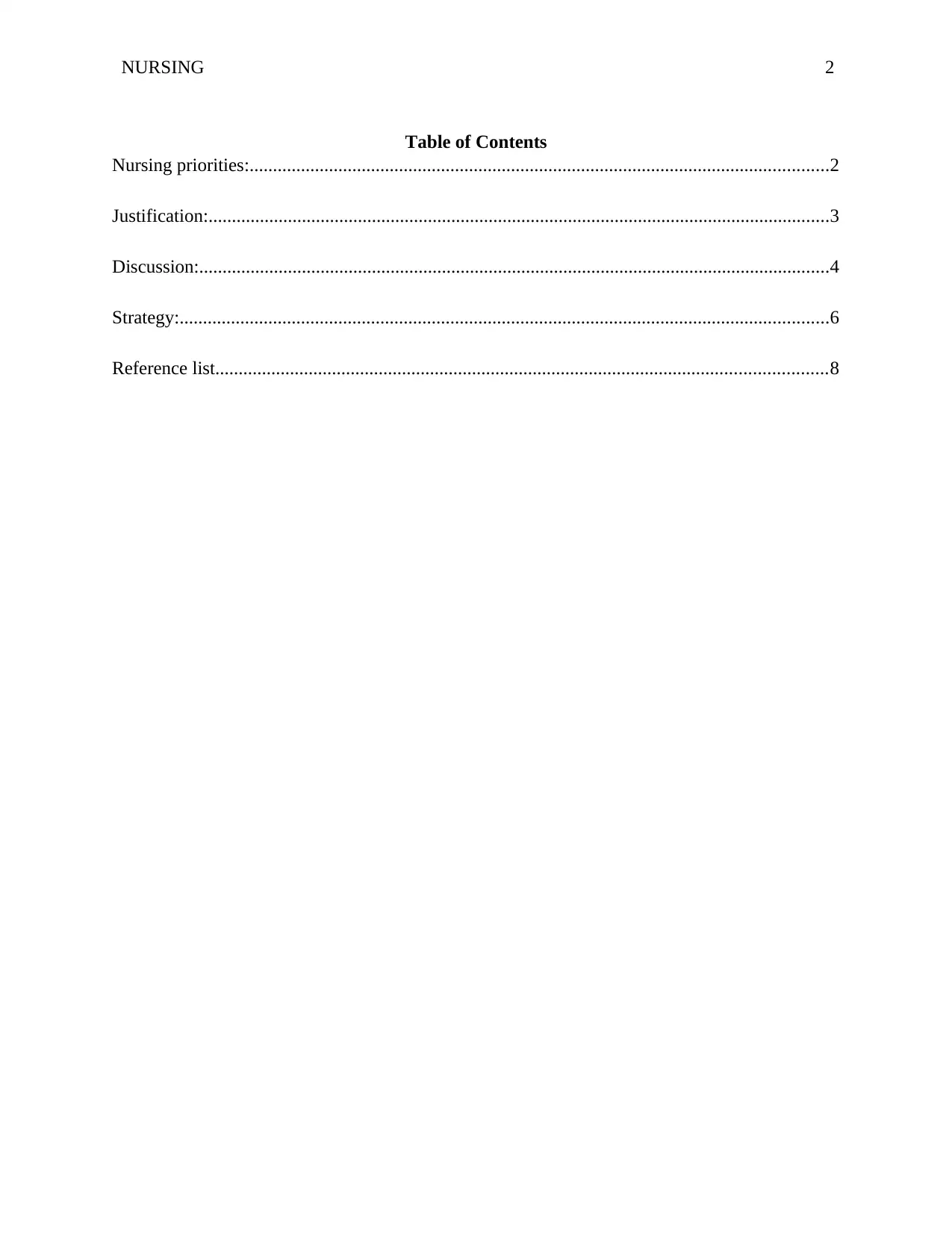
NURSING 2
Table of Contents
Nursing priorities:............................................................................................................................2
Justification:.....................................................................................................................................3
Discussion:.......................................................................................................................................4
Strategy:...........................................................................................................................................6
Reference list...................................................................................................................................8
Table of Contents
Nursing priorities:............................................................................................................................2
Justification:.....................................................................................................................................3
Discussion:.......................................................................................................................................4
Strategy:...........................................................................................................................................6
Reference list...................................................................................................................................8
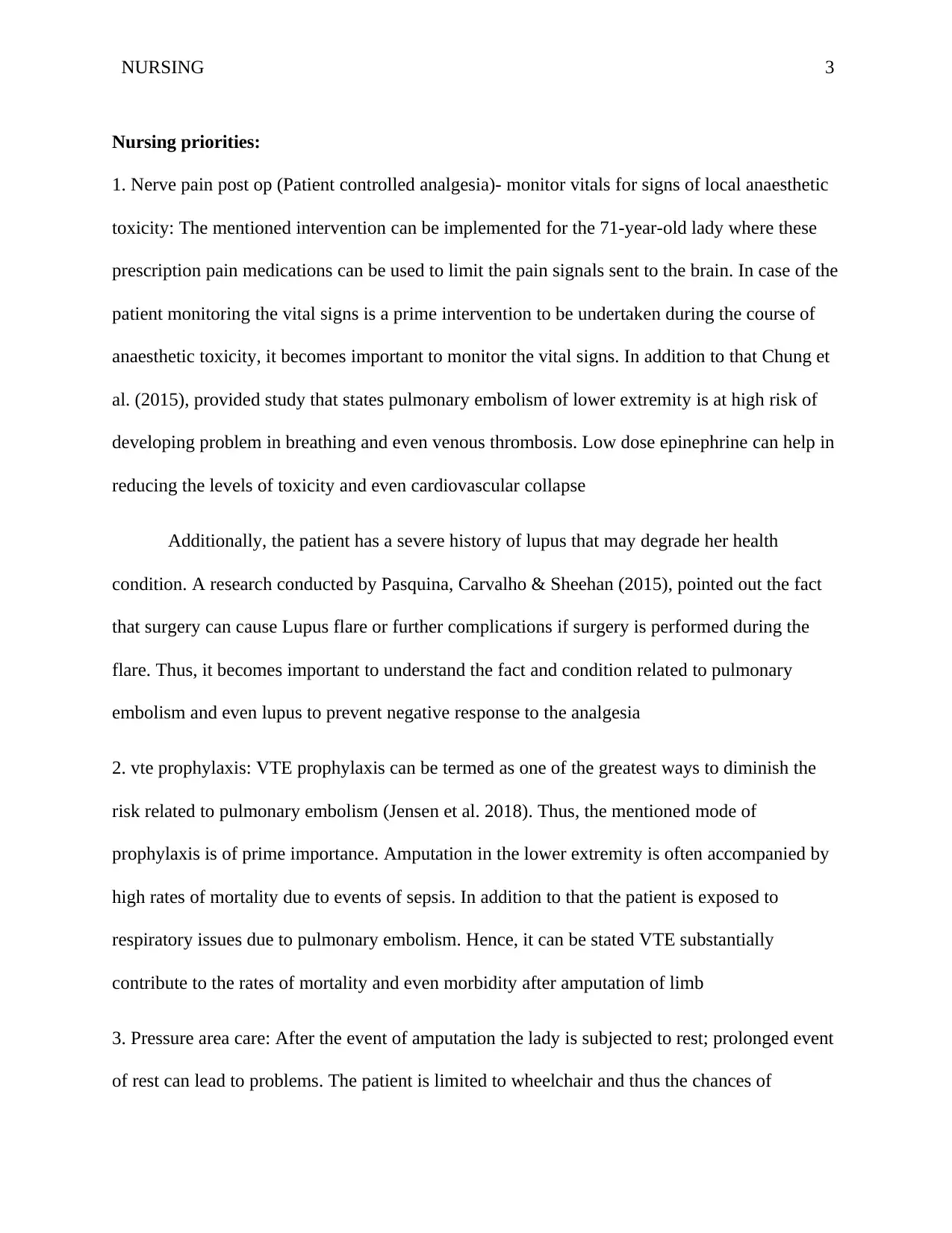
NURSING 3
Nursing priorities:
1. Nerve pain post op (Patient controlled analgesia)- monitor vitals for signs of local anaesthetic
toxicity: The mentioned intervention can be implemented for the 71-year-old lady where these
prescription pain medications can be used to limit the pain signals sent to the brain. In case of the
patient monitoring the vital signs is a prime intervention to be undertaken during the course of
anaesthetic toxicity, it becomes important to monitor the vital signs. In addition to that Chung et
al. (2015), provided study that states pulmonary embolism of lower extremity is at high risk of
developing problem in breathing and even venous thrombosis. Low dose epinephrine can help in
reducing the levels of toxicity and even cardiovascular collapse
Additionally, the patient has a severe history of lupus that may degrade her health
condition. A research conducted by Pasquina, Carvalho & Sheehan (2015), pointed out the fact
that surgery can cause Lupus flare or further complications if surgery is performed during the
flare. Thus, it becomes important to understand the fact and condition related to pulmonary
embolism and even lupus to prevent negative response to the analgesia
2. vte prophylaxis: VTE prophylaxis can be termed as one of the greatest ways to diminish the
risk related to pulmonary embolism (Jensen et al. 2018). Thus, the mentioned mode of
prophylaxis is of prime importance. Amputation in the lower extremity is often accompanied by
high rates of mortality due to events of sepsis. In addition to that the patient is exposed to
respiratory issues due to pulmonary embolism. Hence, it can be stated VTE substantially
contribute to the rates of mortality and even morbidity after amputation of limb
3. Pressure area care: After the event of amputation the lady is subjected to rest; prolonged event
of rest can lead to problems. The patient is limited to wheelchair and thus the chances of
Nursing priorities:
1. Nerve pain post op (Patient controlled analgesia)- monitor vitals for signs of local anaesthetic
toxicity: The mentioned intervention can be implemented for the 71-year-old lady where these
prescription pain medications can be used to limit the pain signals sent to the brain. In case of the
patient monitoring the vital signs is a prime intervention to be undertaken during the course of
anaesthetic toxicity, it becomes important to monitor the vital signs. In addition to that Chung et
al. (2015), provided study that states pulmonary embolism of lower extremity is at high risk of
developing problem in breathing and even venous thrombosis. Low dose epinephrine can help in
reducing the levels of toxicity and even cardiovascular collapse
Additionally, the patient has a severe history of lupus that may degrade her health
condition. A research conducted by Pasquina, Carvalho & Sheehan (2015), pointed out the fact
that surgery can cause Lupus flare or further complications if surgery is performed during the
flare. Thus, it becomes important to understand the fact and condition related to pulmonary
embolism and even lupus to prevent negative response to the analgesia
2. vte prophylaxis: VTE prophylaxis can be termed as one of the greatest ways to diminish the
risk related to pulmonary embolism (Jensen et al. 2018). Thus, the mentioned mode of
prophylaxis is of prime importance. Amputation in the lower extremity is often accompanied by
high rates of mortality due to events of sepsis. In addition to that the patient is exposed to
respiratory issues due to pulmonary embolism. Hence, it can be stated VTE substantially
contribute to the rates of mortality and even morbidity after amputation of limb
3. Pressure area care: After the event of amputation the lady is subjected to rest; prolonged event
of rest can lead to problems. The patient is limited to wheelchair and thus the chances of
⊘ This is a preview!⊘
Do you want full access?
Subscribe today to unlock all pages.

Trusted by 1+ million students worldwide
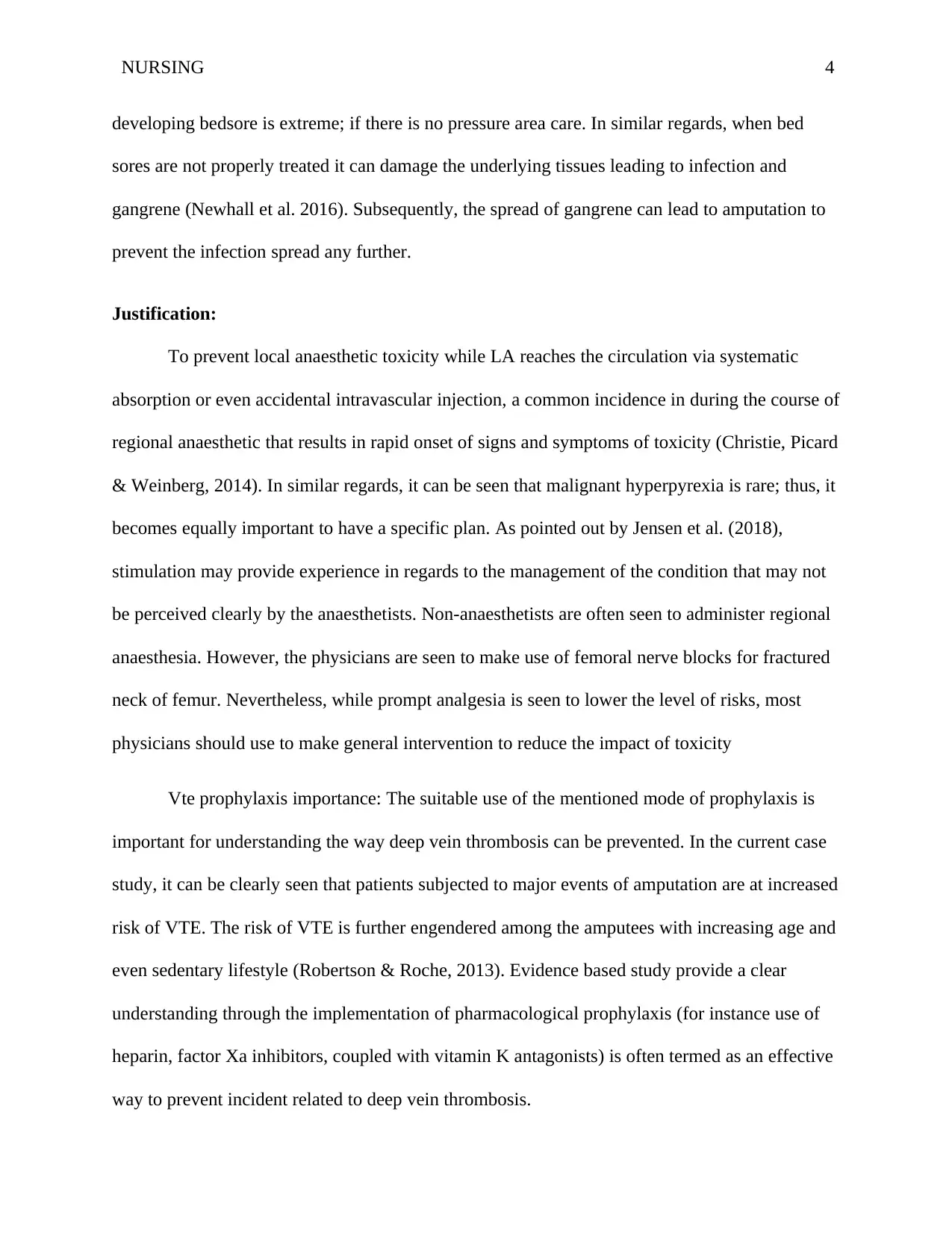
NURSING 4
developing bedsore is extreme; if there is no pressure area care. In similar regards, when bed
sores are not properly treated it can damage the underlying tissues leading to infection and
gangrene (Newhall et al. 2016). Subsequently, the spread of gangrene can lead to amputation to
prevent the infection spread any further.
Justification:
To prevent local anaesthetic toxicity while LA reaches the circulation via systematic
absorption or even accidental intravascular injection, a common incidence in during the course of
regional anaesthetic that results in rapid onset of signs and symptoms of toxicity (Christie, Picard
& Weinberg, 2014). In similar regards, it can be seen that malignant hyperpyrexia is rare; thus, it
becomes equally important to have a specific plan. As pointed out by Jensen et al. (2018),
stimulation may provide experience in regards to the management of the condition that may not
be perceived clearly by the anaesthetists. Non-anaesthetists are often seen to administer regional
anaesthesia. However, the physicians are seen to make use of femoral nerve blocks for fractured
neck of femur. Nevertheless, while prompt analgesia is seen to lower the level of risks, most
physicians should use to make general intervention to reduce the impact of toxicity
Vte prophylaxis importance: The suitable use of the mentioned mode of prophylaxis is
important for understanding the way deep vein thrombosis can be prevented. In the current case
study, it can be clearly seen that patients subjected to major events of amputation are at increased
risk of VTE. The risk of VTE is further engendered among the amputees with increasing age and
even sedentary lifestyle (Robertson & Roche, 2013). Evidence based study provide a clear
understanding through the implementation of pharmacological prophylaxis (for instance use of
heparin, factor Xa inhibitors, coupled with vitamin K antagonists) is often termed as an effective
way to prevent incident related to deep vein thrombosis.
developing bedsore is extreme; if there is no pressure area care. In similar regards, when bed
sores are not properly treated it can damage the underlying tissues leading to infection and
gangrene (Newhall et al. 2016). Subsequently, the spread of gangrene can lead to amputation to
prevent the infection spread any further.
Justification:
To prevent local anaesthetic toxicity while LA reaches the circulation via systematic
absorption or even accidental intravascular injection, a common incidence in during the course of
regional anaesthetic that results in rapid onset of signs and symptoms of toxicity (Christie, Picard
& Weinberg, 2014). In similar regards, it can be seen that malignant hyperpyrexia is rare; thus, it
becomes equally important to have a specific plan. As pointed out by Jensen et al. (2018),
stimulation may provide experience in regards to the management of the condition that may not
be perceived clearly by the anaesthetists. Non-anaesthetists are often seen to administer regional
anaesthesia. However, the physicians are seen to make use of femoral nerve blocks for fractured
neck of femur. Nevertheless, while prompt analgesia is seen to lower the level of risks, most
physicians should use to make general intervention to reduce the impact of toxicity
Vte prophylaxis importance: The suitable use of the mentioned mode of prophylaxis is
important for understanding the way deep vein thrombosis can be prevented. In the current case
study, it can be clearly seen that patients subjected to major events of amputation are at increased
risk of VTE. The risk of VTE is further engendered among the amputees with increasing age and
even sedentary lifestyle (Robertson & Roche, 2013). Evidence based study provide a clear
understanding through the implementation of pharmacological prophylaxis (for instance use of
heparin, factor Xa inhibitors, coupled with vitamin K antagonists) is often termed as an effective
way to prevent incident related to deep vein thrombosis.
Paraphrase This Document
Need a fresh take? Get an instant paraphrase of this document with our AI Paraphraser
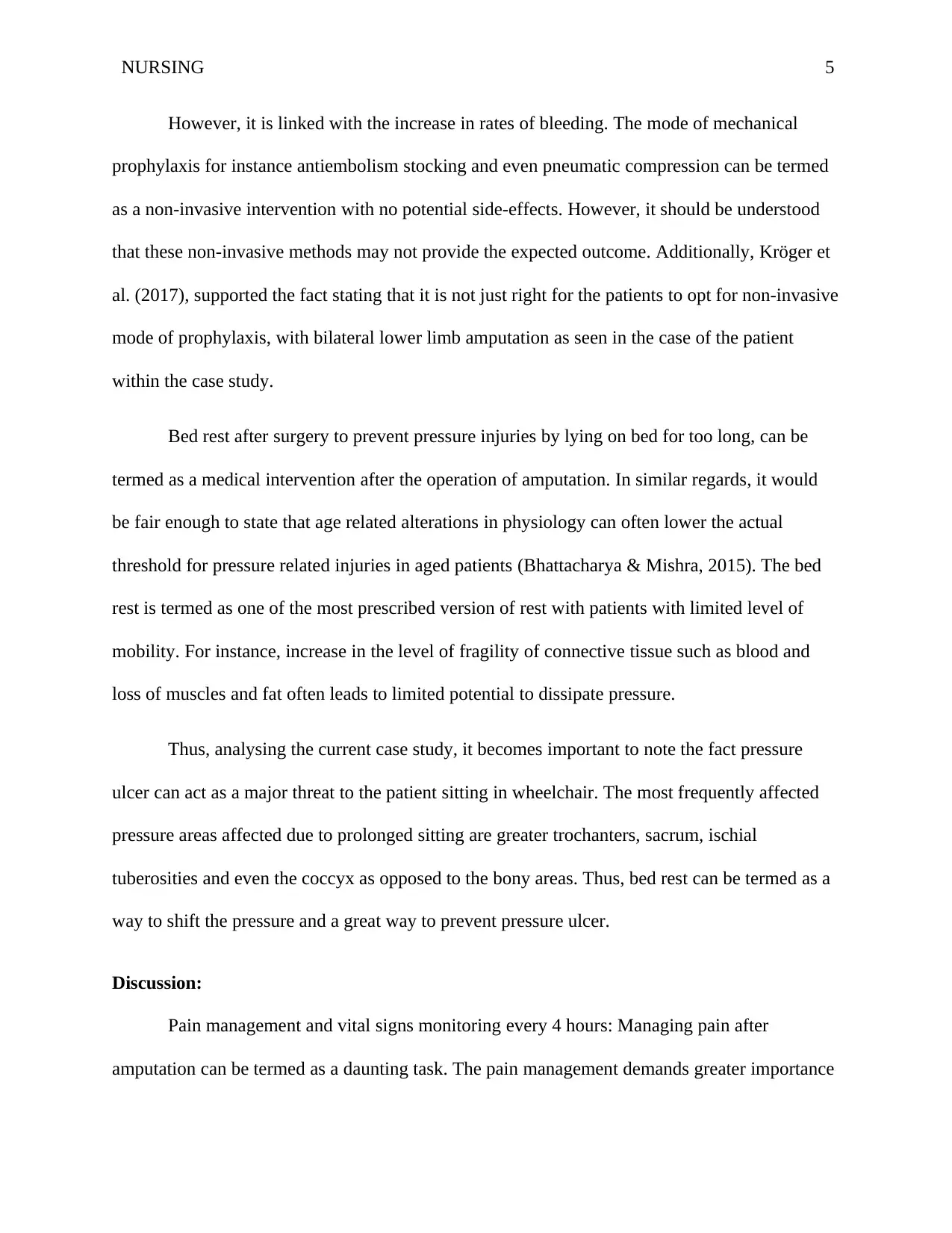
NURSING 5
However, it is linked with the increase in rates of bleeding. The mode of mechanical
prophylaxis for instance antiembolism stocking and even pneumatic compression can be termed
as a non-invasive intervention with no potential side-effects. However, it should be understood
that these non-invasive methods may not provide the expected outcome. Additionally, Kröger et
al. (2017), supported the fact stating that it is not just right for the patients to opt for non-invasive
mode of prophylaxis, with bilateral lower limb amputation as seen in the case of the patient
within the case study.
Bed rest after surgery to prevent pressure injuries by lying on bed for too long, can be
termed as a medical intervention after the operation of amputation. In similar regards, it would
be fair enough to state that age related alterations in physiology can often lower the actual
threshold for pressure related injuries in aged patients (Bhattacharya & Mishra, 2015). The bed
rest is termed as one of the most prescribed version of rest with patients with limited level of
mobility. For instance, increase in the level of fragility of connective tissue such as blood and
loss of muscles and fat often leads to limited potential to dissipate pressure.
Thus, analysing the current case study, it becomes important to note the fact pressure
ulcer can act as a major threat to the patient sitting in wheelchair. The most frequently affected
pressure areas affected due to prolonged sitting are greater trochanters, sacrum, ischial
tuberosities and even the coccyx as opposed to the bony areas. Thus, bed rest can be termed as a
way to shift the pressure and a great way to prevent pressure ulcer.
Discussion:
Pain management and vital signs monitoring every 4 hours: Managing pain after
amputation can be termed as a daunting task. The pain management demands greater importance
However, it is linked with the increase in rates of bleeding. The mode of mechanical
prophylaxis for instance antiembolism stocking and even pneumatic compression can be termed
as a non-invasive intervention with no potential side-effects. However, it should be understood
that these non-invasive methods may not provide the expected outcome. Additionally, Kröger et
al. (2017), supported the fact stating that it is not just right for the patients to opt for non-invasive
mode of prophylaxis, with bilateral lower limb amputation as seen in the case of the patient
within the case study.
Bed rest after surgery to prevent pressure injuries by lying on bed for too long, can be
termed as a medical intervention after the operation of amputation. In similar regards, it would
be fair enough to state that age related alterations in physiology can often lower the actual
threshold for pressure related injuries in aged patients (Bhattacharya & Mishra, 2015). The bed
rest is termed as one of the most prescribed version of rest with patients with limited level of
mobility. For instance, increase in the level of fragility of connective tissue such as blood and
loss of muscles and fat often leads to limited potential to dissipate pressure.
Thus, analysing the current case study, it becomes important to note the fact pressure
ulcer can act as a major threat to the patient sitting in wheelchair. The most frequently affected
pressure areas affected due to prolonged sitting are greater trochanters, sacrum, ischial
tuberosities and even the coccyx as opposed to the bony areas. Thus, bed rest can be termed as a
way to shift the pressure and a great way to prevent pressure ulcer.
Discussion:
Pain management and vital signs monitoring every 4 hours: Managing pain after
amputation can be termed as a daunting task. The pain management demands greater importance
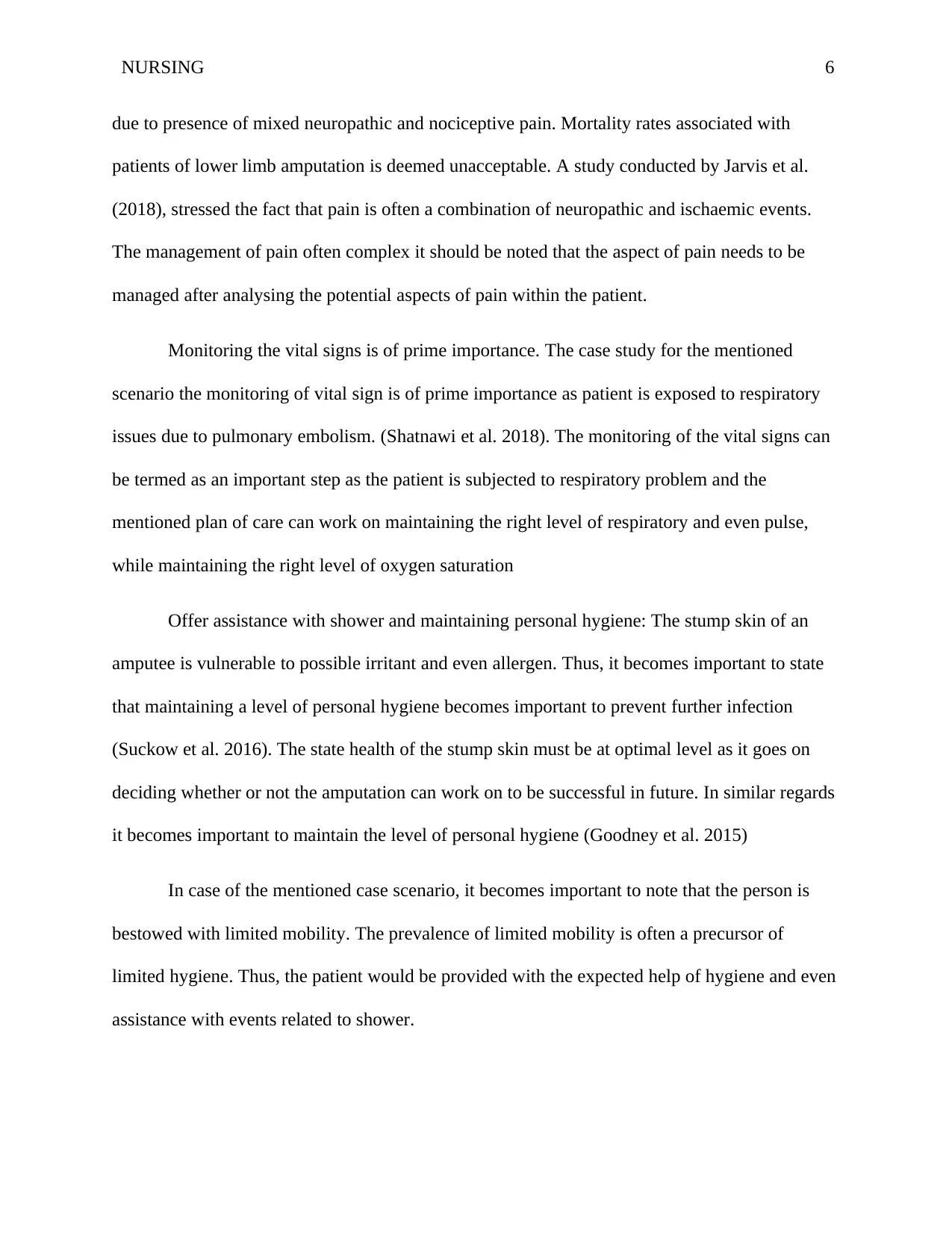
NURSING 6
due to presence of mixed neuropathic and nociceptive pain. Mortality rates associated with
patients of lower limb amputation is deemed unacceptable. A study conducted by Jarvis et al.
(2018), stressed the fact that pain is often a combination of neuropathic and ischaemic events.
The management of pain often complex it should be noted that the aspect of pain needs to be
managed after analysing the potential aspects of pain within the patient.
Monitoring the vital signs is of prime importance. The case study for the mentioned
scenario the monitoring of vital sign is of prime importance as patient is exposed to respiratory
issues due to pulmonary embolism. (Shatnawi et al. 2018). The monitoring of the vital signs can
be termed as an important step as the patient is subjected to respiratory problem and the
mentioned plan of care can work on maintaining the right level of respiratory and even pulse,
while maintaining the right level of oxygen saturation
Offer assistance with shower and maintaining personal hygiene: The stump skin of an
amputee is vulnerable to possible irritant and even allergen. Thus, it becomes important to state
that maintaining a level of personal hygiene becomes important to prevent further infection
(Suckow et al. 2016). The state health of the stump skin must be at optimal level as it goes on
deciding whether or not the amputation can work on to be successful in future. In similar regards
it becomes important to maintain the level of personal hygiene (Goodney et al. 2015)
In case of the mentioned case scenario, it becomes important to note that the person is
bestowed with limited mobility. The prevalence of limited mobility is often a precursor of
limited hygiene. Thus, the patient would be provided with the expected help of hygiene and even
assistance with events related to shower.
due to presence of mixed neuropathic and nociceptive pain. Mortality rates associated with
patients of lower limb amputation is deemed unacceptable. A study conducted by Jarvis et al.
(2018), stressed the fact that pain is often a combination of neuropathic and ischaemic events.
The management of pain often complex it should be noted that the aspect of pain needs to be
managed after analysing the potential aspects of pain within the patient.
Monitoring the vital signs is of prime importance. The case study for the mentioned
scenario the monitoring of vital sign is of prime importance as patient is exposed to respiratory
issues due to pulmonary embolism. (Shatnawi et al. 2018). The monitoring of the vital signs can
be termed as an important step as the patient is subjected to respiratory problem and the
mentioned plan of care can work on maintaining the right level of respiratory and even pulse,
while maintaining the right level of oxygen saturation
Offer assistance with shower and maintaining personal hygiene: The stump skin of an
amputee is vulnerable to possible irritant and even allergen. Thus, it becomes important to state
that maintaining a level of personal hygiene becomes important to prevent further infection
(Suckow et al. 2016). The state health of the stump skin must be at optimal level as it goes on
deciding whether or not the amputation can work on to be successful in future. In similar regards
it becomes important to maintain the level of personal hygiene (Goodney et al. 2015)
In case of the mentioned case scenario, it becomes important to note that the person is
bestowed with limited mobility. The prevalence of limited mobility is often a precursor of
limited hygiene. Thus, the patient would be provided with the expected help of hygiene and even
assistance with events related to shower.
⊘ This is a preview!⊘
Do you want full access?
Subscribe today to unlock all pages.

Trusted by 1+ million students worldwide
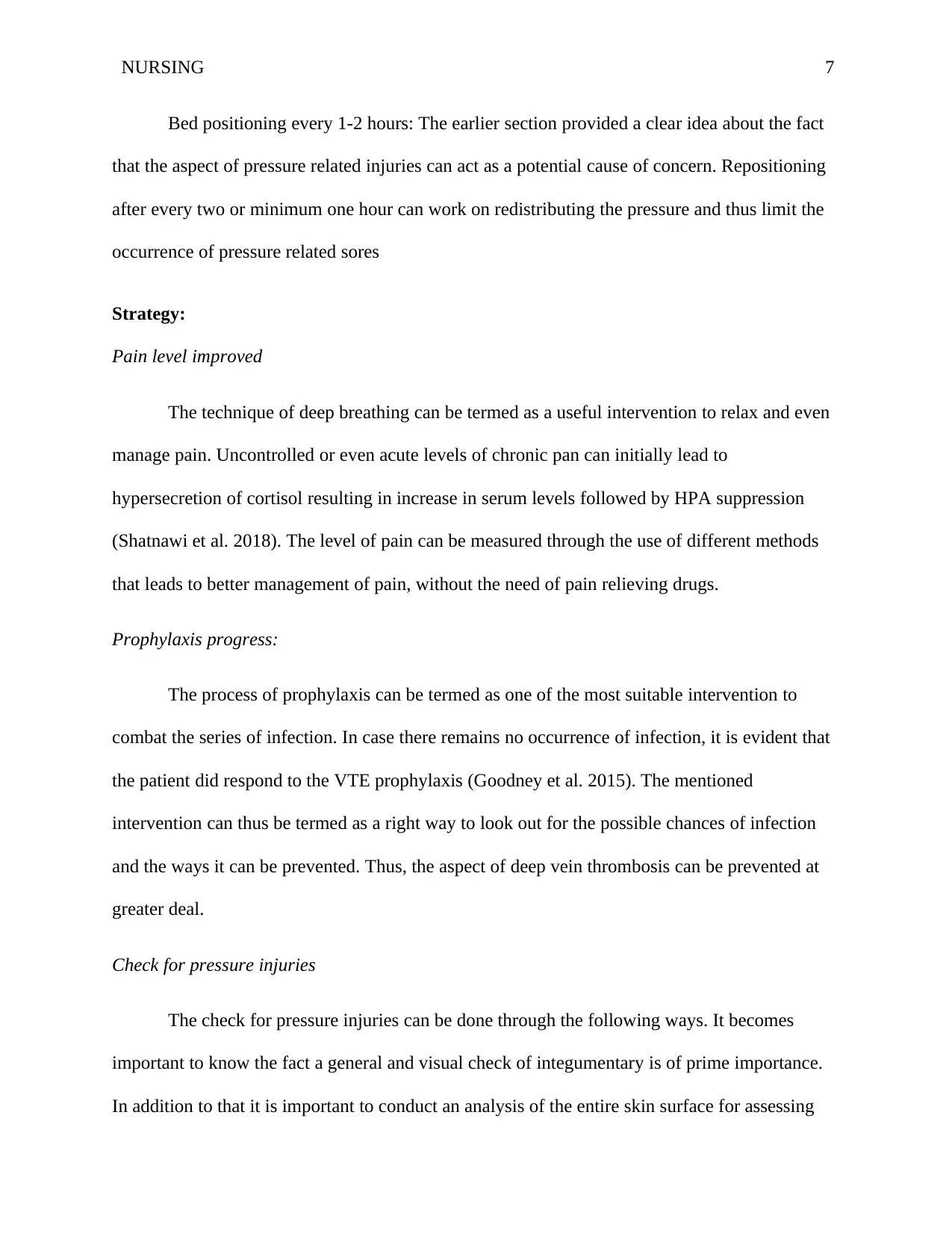
NURSING 7
Bed positioning every 1-2 hours: The earlier section provided a clear idea about the fact
that the aspect of pressure related injuries can act as a potential cause of concern. Repositioning
after every two or minimum one hour can work on redistributing the pressure and thus limit the
occurrence of pressure related sores
Strategy:
Pain level improved
The technique of deep breathing can be termed as a useful intervention to relax and even
manage pain. Uncontrolled or even acute levels of chronic pan can initially lead to
hypersecretion of cortisol resulting in increase in serum levels followed by HPA suppression
(Shatnawi et al. 2018). The level of pain can be measured through the use of different methods
that leads to better management of pain, without the need of pain relieving drugs.
Prophylaxis progress:
The process of prophylaxis can be termed as one of the most suitable intervention to
combat the series of infection. In case there remains no occurrence of infection, it is evident that
the patient did respond to the VTE prophylaxis (Goodney et al. 2015). The mentioned
intervention can thus be termed as a right way to look out for the possible chances of infection
and the ways it can be prevented. Thus, the aspect of deep vein thrombosis can be prevented at
greater deal.
Check for pressure injuries
The check for pressure injuries can be done through the following ways. It becomes
important to know the fact a general and visual check of integumentary is of prime importance.
In addition to that it is important to conduct an analysis of the entire skin surface for assessing
Bed positioning every 1-2 hours: The earlier section provided a clear idea about the fact
that the aspect of pressure related injuries can act as a potential cause of concern. Repositioning
after every two or minimum one hour can work on redistributing the pressure and thus limit the
occurrence of pressure related sores
Strategy:
Pain level improved
The technique of deep breathing can be termed as a useful intervention to relax and even
manage pain. Uncontrolled or even acute levels of chronic pan can initially lead to
hypersecretion of cortisol resulting in increase in serum levels followed by HPA suppression
(Shatnawi et al. 2018). The level of pain can be measured through the use of different methods
that leads to better management of pain, without the need of pain relieving drugs.
Prophylaxis progress:
The process of prophylaxis can be termed as one of the most suitable intervention to
combat the series of infection. In case there remains no occurrence of infection, it is evident that
the patient did respond to the VTE prophylaxis (Goodney et al. 2015). The mentioned
intervention can thus be termed as a right way to look out for the possible chances of infection
and the ways it can be prevented. Thus, the aspect of deep vein thrombosis can be prevented at
greater deal.
Check for pressure injuries
The check for pressure injuries can be done through the following ways. It becomes
important to know the fact a general and visual check of integumentary is of prime importance.
In addition to that it is important to conduct an analysis of the entire skin surface for assessing
Paraphrase This Document
Need a fresh take? Get an instant paraphrase of this document with our AI Paraphraser

NURSING 8
the possibility of existing skin integrity (Newhall et al. 2016). The assessment is often carried out
to identify the possible characteristics of signs that indicate the onset of pressure related damage.
In addition to that, it becomes important to check the skin beneath dressing and even the
prosthetics and amputations
the possibility of existing skin integrity (Newhall et al. 2016). The assessment is often carried out
to identify the possible characteristics of signs that indicate the onset of pressure related damage.
In addition to that, it becomes important to check the skin beneath dressing and even the
prosthetics and amputations
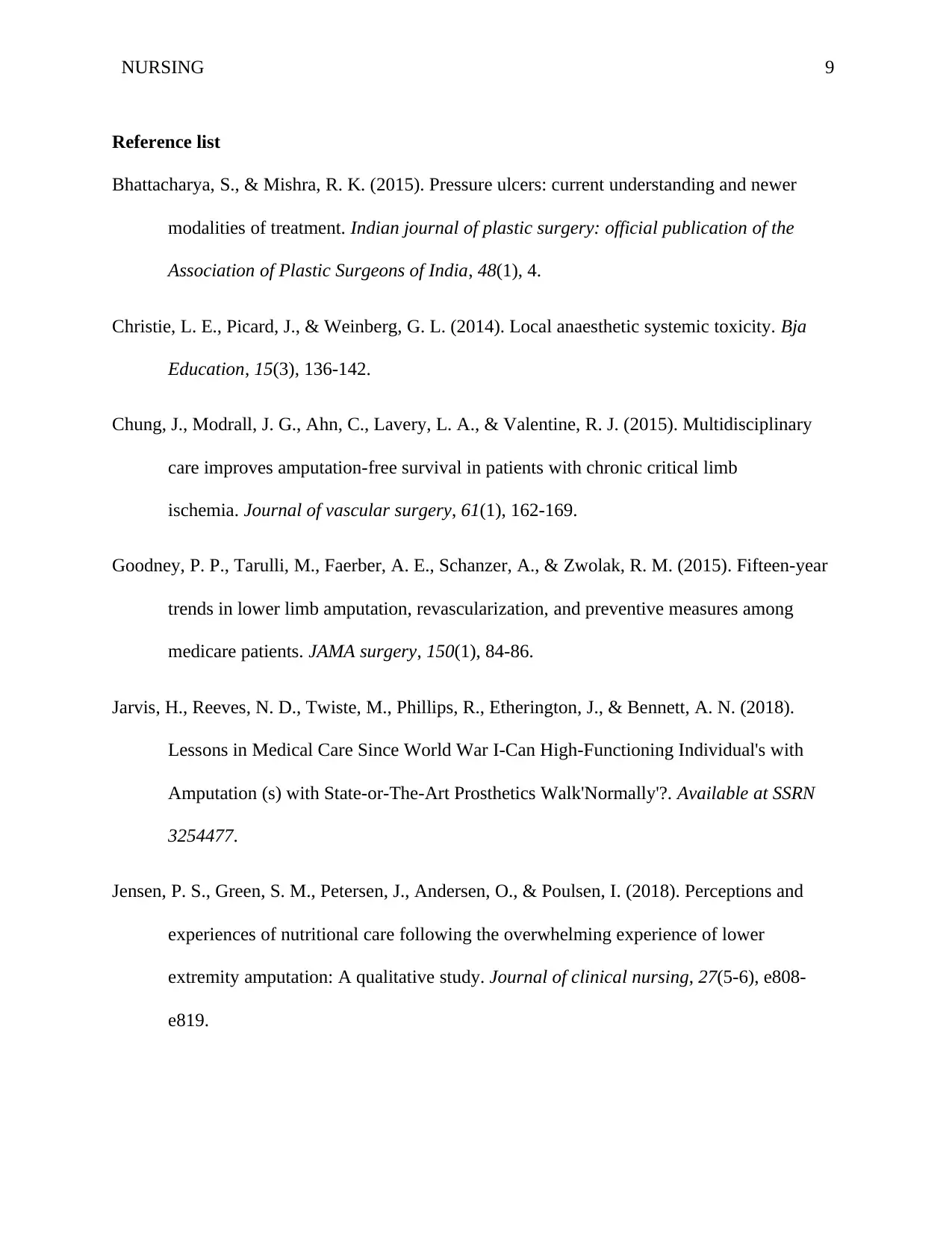
NURSING 9
Reference list
Bhattacharya, S., & Mishra, R. K. (2015). Pressure ulcers: current understanding and newer
modalities of treatment. Indian journal of plastic surgery: official publication of the
Association of Plastic Surgeons of India, 48(1), 4.
Christie, L. E., Picard, J., & Weinberg, G. L. (2014). Local anaesthetic systemic toxicity. Bja
Education, 15(3), 136-142.
Chung, J., Modrall, J. G., Ahn, C., Lavery, L. A., & Valentine, R. J. (2015). Multidisciplinary
care improves amputation-free survival in patients with chronic critical limb
ischemia. Journal of vascular surgery, 61(1), 162-169.
Goodney, P. P., Tarulli, M., Faerber, A. E., Schanzer, A., & Zwolak, R. M. (2015). Fifteen-year
trends in lower limb amputation, revascularization, and preventive measures among
medicare patients. JAMA surgery, 150(1), 84-86.
Jarvis, H., Reeves, N. D., Twiste, M., Phillips, R., Etherington, J., & Bennett, A. N. (2018).
Lessons in Medical Care Since World War I-Can High-Functioning Individual's with
Amputation (s) with State-or-The-Art Prosthetics Walk'Normally'?. Available at SSRN
3254477.
Jensen, P. S., Green, S. M., Petersen, J., Andersen, O., & Poulsen, I. (2018). Perceptions and
experiences of nutritional care following the overwhelming experience of lower
extremity amputation: A qualitative study. Journal of clinical nursing, 27(5-6), e808-
e819.
Reference list
Bhattacharya, S., & Mishra, R. K. (2015). Pressure ulcers: current understanding and newer
modalities of treatment. Indian journal of plastic surgery: official publication of the
Association of Plastic Surgeons of India, 48(1), 4.
Christie, L. E., Picard, J., & Weinberg, G. L. (2014). Local anaesthetic systemic toxicity. Bja
Education, 15(3), 136-142.
Chung, J., Modrall, J. G., Ahn, C., Lavery, L. A., & Valentine, R. J. (2015). Multidisciplinary
care improves amputation-free survival in patients with chronic critical limb
ischemia. Journal of vascular surgery, 61(1), 162-169.
Goodney, P. P., Tarulli, M., Faerber, A. E., Schanzer, A., & Zwolak, R. M. (2015). Fifteen-year
trends in lower limb amputation, revascularization, and preventive measures among
medicare patients. JAMA surgery, 150(1), 84-86.
Jarvis, H., Reeves, N. D., Twiste, M., Phillips, R., Etherington, J., & Bennett, A. N. (2018).
Lessons in Medical Care Since World War I-Can High-Functioning Individual's with
Amputation (s) with State-or-The-Art Prosthetics Walk'Normally'?. Available at SSRN
3254477.
Jensen, P. S., Green, S. M., Petersen, J., Andersen, O., & Poulsen, I. (2018). Perceptions and
experiences of nutritional care following the overwhelming experience of lower
extremity amputation: A qualitative study. Journal of clinical nursing, 27(5-6), e808-
e819.
⊘ This is a preview!⊘
Do you want full access?
Subscribe today to unlock all pages.

Trusted by 1+ million students worldwide
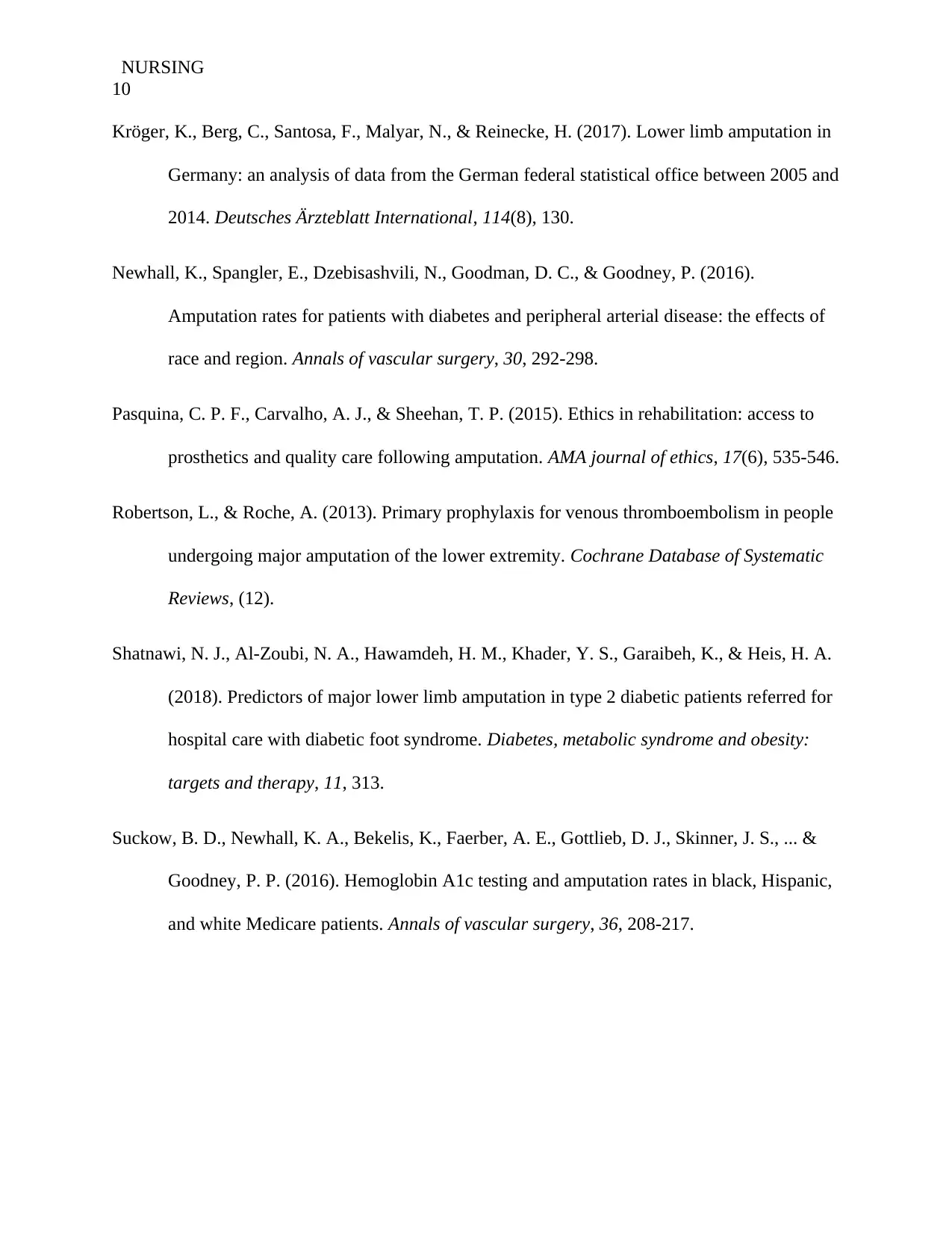
NURSING
10
Kröger, K., Berg, C., Santosa, F., Malyar, N., & Reinecke, H. (2017). Lower limb amputation in
Germany: an analysis of data from the German federal statistical office between 2005 and
2014. Deutsches Ärzteblatt International, 114(8), 130.
Newhall, K., Spangler, E., Dzebisashvili, N., Goodman, D. C., & Goodney, P. (2016).
Amputation rates for patients with diabetes and peripheral arterial disease: the effects of
race and region. Annals of vascular surgery, 30, 292-298.
Pasquina, C. P. F., Carvalho, A. J., & Sheehan, T. P. (2015). Ethics in rehabilitation: access to
prosthetics and quality care following amputation. AMA journal of ethics, 17(6), 535-546.
Robertson, L., & Roche, A. (2013). Primary prophylaxis for venous thromboembolism in people
undergoing major amputation of the lower extremity. Cochrane Database of Systematic
Reviews, (12).
Shatnawi, N. J., Al-Zoubi, N. A., Hawamdeh, H. M., Khader, Y. S., Garaibeh, K., & Heis, H. A.
(2018). Predictors of major lower limb amputation in type 2 diabetic patients referred for
hospital care with diabetic foot syndrome. Diabetes, metabolic syndrome and obesity:
targets and therapy, 11, 313.
Suckow, B. D., Newhall, K. A., Bekelis, K., Faerber, A. E., Gottlieb, D. J., Skinner, J. S., ... &
Goodney, P. P. (2016). Hemoglobin A1c testing and amputation rates in black, Hispanic,
and white Medicare patients. Annals of vascular surgery, 36, 208-217.
10
Kröger, K., Berg, C., Santosa, F., Malyar, N., & Reinecke, H. (2017). Lower limb amputation in
Germany: an analysis of data from the German federal statistical office between 2005 and
2014. Deutsches Ärzteblatt International, 114(8), 130.
Newhall, K., Spangler, E., Dzebisashvili, N., Goodman, D. C., & Goodney, P. (2016).
Amputation rates for patients with diabetes and peripheral arterial disease: the effects of
race and region. Annals of vascular surgery, 30, 292-298.
Pasquina, C. P. F., Carvalho, A. J., & Sheehan, T. P. (2015). Ethics in rehabilitation: access to
prosthetics and quality care following amputation. AMA journal of ethics, 17(6), 535-546.
Robertson, L., & Roche, A. (2013). Primary prophylaxis for venous thromboembolism in people
undergoing major amputation of the lower extremity. Cochrane Database of Systematic
Reviews, (12).
Shatnawi, N. J., Al-Zoubi, N. A., Hawamdeh, H. M., Khader, Y. S., Garaibeh, K., & Heis, H. A.
(2018). Predictors of major lower limb amputation in type 2 diabetic patients referred for
hospital care with diabetic foot syndrome. Diabetes, metabolic syndrome and obesity:
targets and therapy, 11, 313.
Suckow, B. D., Newhall, K. A., Bekelis, K., Faerber, A. E., Gottlieb, D. J., Skinner, J. S., ... &
Goodney, P. P. (2016). Hemoglobin A1c testing and amputation rates in black, Hispanic,
and white Medicare patients. Annals of vascular surgery, 36, 208-217.
1 out of 10
Your All-in-One AI-Powered Toolkit for Academic Success.
+13062052269
info@desklib.com
Available 24*7 on WhatsApp / Email
![[object Object]](/_next/static/media/star-bottom.7253800d.svg)
Unlock your academic potential
Copyright © 2020–2025 A2Z Services. All Rights Reserved. Developed and managed by ZUCOL.